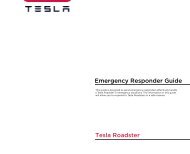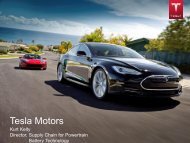You also want an ePaper? Increase the reach of your titles
YUMPU automatically turns print PDFs into web optimized ePapers that Google loves.
University of Oregon Investment Group<br />
Net Working Capital<br />
April 18, 2013<br />
Accounting for the new financing option creates a large increase in liabilities<br />
and has no effect on current assets because the firm receives cash when the car<br />
is originally sold. Due to this large relative increase in current liabilities the<br />
change in net working capital year to year is large and negative.<br />
Other line items in the Working Capital Model were calculated based off of<br />
historical percentage of revenue and historical trends.<br />
Restricted Cash is cash reserved for repayments to the Department of Energy<br />
(DOE) for the loan <strong>Tesla</strong> received. The DOE loan matures in 2017 so we<br />
gradually trended the value in restricted cash down to zero.<br />
We projected that Accounts Payable would decrease as a percentage of revenue.<br />
In the year 2012 the large increase was in relation to the pushing back of<br />
payments for their factory. The company pushed back payments because the<br />
firm was aiming to become cash flow positive for the first time since inception.<br />
Going forward we projected this line item to stay around the level of the prior<br />
three years because the firm will become profitable and will be able to pay its<br />
liabilities quicker.<br />
Capital Expenditures<br />
Capital Expenditures consist of investments in on the <strong>Tesla</strong> factory and tooling<br />
for their products machinery as well as the building of service and store<br />
networks. In 2013 the firm plans to spend significantly less on capital<br />
expenditures because the majority of the investment in the <strong>Tesla</strong> factory and<br />
Model S tooling machinery have concluded. The decrease in spending on the<br />
<strong>Tesla</strong> factory and Model S tooling machinery will be slightly offset by their<br />
increase in service centers and stores.<br />
In 2013 <strong>Tesla</strong> plans to open 10 new stores and 23 new service centers. Based on<br />
this information we projected 2013 CAPEX based on a nominal value that we<br />
believed to be consistent with management guidance. Going forward, we<br />
projected CAPEX as a percent of revenue relative to the 2013 projection. We<br />
increased the percent of revenue in 2014 because the firm will begin production<br />
of the Model X. Although the Model X will be built on a similar platform as the<br />
Model S, there are significant differences that will force <strong>Tesla</strong> to incur higher<br />
CAPEX. After 2014 we trended CAPEX down as a percent of revenue until<br />
2017 when we increased CAPEX to represent our projection that <strong>Tesla</strong> will<br />
begin production of the cheaper Model S. In 2018 we trended down CAPEX to<br />
what we believe is a reasonable terminal percentage of revenue.<br />
UOIG 19







